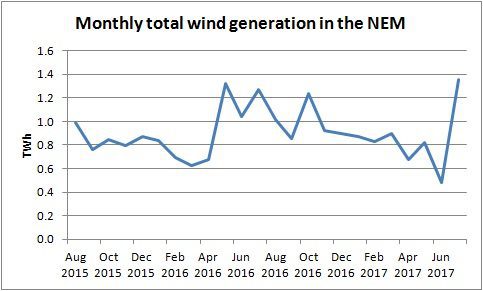Output from wind farms hit a record high in Australia in July – reaching 1.36 terawatt hours – while the combined impact of wind and solar accounted for nearly 60 per cent of electricity supplied in South Australia.
The figures, released by The Australia Institute’s latest monthly Electricity Update of the National Energy Emissions Audit for August, show that total wind generation smashed records in South Australia, reaching 14 per cent more than any previous month, and also reached record levels in Victoria.
The records reflect the addition of new wind farms in both states, with both (Hornsdale stage 2 in South Australia and Ararat in Victoria) underwritten by the ACT government’s 100 per cent renewable energy target and its successful series of reverse auctions.
The most remarkable figure came in South Australia, which has the nation’s biggest wind capacity – more than 1.65GW – and where wind generation exceeded 52 per cent of total electricity supplied in the state through the NEM, i.e. excluding rooftop solar.
Hugh Saddler, the report’s author, said that when solar is added, the renewable share of total supply in the state during the month reached an average level of 59 per cent. Total wind generation exceeded total state demand for 48 hours across seven separate days during the month, by an average of over 7 per cent.
The report says that monthly wind generation in SA would have been even higher, but for the curtailment ordered by AEMO, in its role as system operator, of output from several wind farms.
This was imposed under new system security procedures at times when gas generation within the state had fallen to levels which were considered to make the system insecure in the event of a major disruption, such as a failure of the Heywood interconnector.
Despite the curtailments, the average capacity factor for wind generators in SA during the whole of July was 49 per cent, Saddler says. This followed a record low in June.
On the national level, this surge in wind power helped achieve a reduction in emissions from the electricity sector for the month. Overall demand was dead flat, with Saddler attributing this to the consumer response to every rising electricity prices.
“This year consumers have seen a very sharp rise in electricity price due to generation costs. However, for the last six years price rises seen by consumers were almost entirely caused by network ‘gold-plating’,” he notes. He goes into more detail of that analysis here.
The fall in emissions in the past month is also the result of the closure of the Hazelwood brown coal generator, which has seen more black coal generation.
“The retirement of decrepit brown coal plants in Victoria had the potential to limit supply and cause price rises, but South Australian wind has come to the rescue keeping the lights on and putting downward pressure on wholesale prices,” Saddler said.
He also noted that the closure of Hazlwood has led to a restructuring of electricity flows between the three main regions of the NEM, reflecting the changed relationship between available generation capacity and the short run marginal cost of generation.
During July, 10% of the electrical energy consumed in NSW was, in net terms, imported from Queensland, while 2% of the electricity consumed in Victoria was imported, in net terms, from NSW.
The flow from NSW to Victoria would have been higher, but for the fact that very high levels of wind generation meant that net imports from SA supplied a further 3 per cent of Victoria’s electricity consumption for the month. SA is a usually net importer from Victoria.
“For the NEM as a whole, lower brown coal generation, because of the closure of Hazelwood, was almost precisely matched by the increase in less emissions intensive black coal generation. Hence, while the coal share of total generation was unchanged, emissions went down,” Saddler writes.
Saddler says that because of the relative youth of the Queensland coal generators there may be an argument to build a new transmission line linking NSW and South Australia as the transition away from coal and towards wind and solar generation develops.










